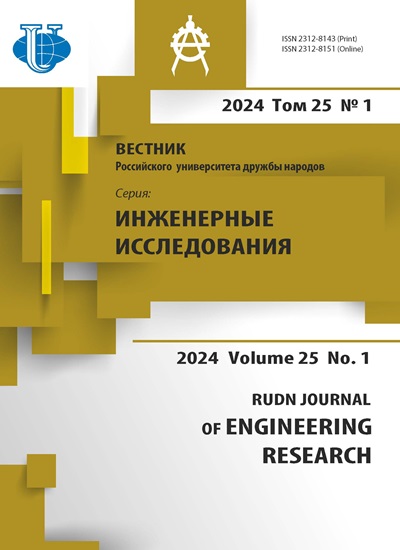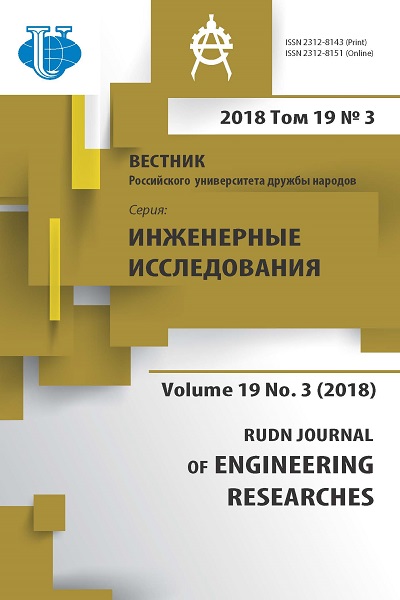Application of computer processing of experimental data from analysis of chip formation zone on photoelastic models
- Authors: Zhed O.V1, Kopylov V.V1
-
Affiliations:
- Peoples’ Friendship University of Russia (RUDN University)
- Issue: Vol 19, No 3 (2018)
- Pages: 277-288
- Section: Mechanical engineering and power-plant
- URL: https://journals.rudn.ru/engineering-researches/article/view/19250
- DOI: https://doi.org/10.22363/2312-8143-2018-19-3-277-288
Cite item
Full Text
Abstract
In the experiments carried out using photomechanical method, only the isochrome pattern is directly recorded on photoelastic models and the isoclines (lines of equal angles of inclination of the principal stresses) must be traced manually for each of the fixed values of the polarization planes. Further processing is also performed manually, isostatic lines (trajectories of principal stresses) are constructed from the isocline pattern, and the field of the slip lines, or maximum tangential stresses, is constructed from the obtained isostatic field. Such multi-step path (isoclines-isostatic lines-slip lines) containing manual processing at each stage leads to accumulation of errors. The research presented in the article largely removes these problems. In order to actualize a load similar to the one acting on the wedge front surface, a large-scale photoelastic model and a special experimental stand were developed. The scale of the model (10:1) was chosen as great as practicable from the condition of its placement in the optical field of the PPU-7 (plane polarization unit). The scheme of chip formation, the shape of the photoelastic model and its loading is given. The scheme of the stand for loading the chip formation zone of the model under study is described. The task of reducing labor intensity of the experimental part and increasing the accuracy of the obtained results was solved by using a digital camera and a specially developed technology for computer processing of photograms. Pressure diagram describes the nature of loading models in experiments. The results of the experiments were presented in the form of a series of digital photographs subjected to further computer processing, the purpose of which was to obtain isocline mesh, construct isostatic lines field, and then fields of slip lines. Analysis of the application of digital recording and computer processing of photograms significantly reduce time of performing the experimental part by abandoning the traditional method of drawing isoclines on tracing paper. In addition, the accuracy of the fields of the isostatic and slip lines increases because in the initial for their construction isocline field errors that are unavoidable with manual fixation are eliminated.
Keywords
About the authors
Olga V Zhed
Peoples’ Friendship University of Russia (RUDN University)
Author for correspondence.
Email: zhed_ov@pfur.ru
Candidate of Technical Sciences, associate professor of the Department of Mechanical Engineering and Instrumentation, Engineering Academy, Peoples’ Friendship University of Russia (RUDN University). Research interests: photomechanics in mechanical engineering, cutting tools
6, Miklukho-Maklaya str., Moscow, 117198, Russian FederationVladimir V Kopylov
Peoples’ Friendship University of Russia (RUDN University)
Email: kopylov_vv@rudn.university
Candidate of Technical Sciences, associate professor of the Department of Mechanical Engineering and Instrumentation, Engineering Academy, Peoples’ Friendship University of Russia (RUDN University). Research interests: nanotechnology, photomechanics in mechanical engineering, cutting tools
6, Miklukho-Maklaya str., Moscow, 117198, Russian FederationReferences
- Koshelenko A.S., Poznyak G.G. Teoreticheskie osnovy i praktika fotomehaniki v mashinostroenii [Theoretical foundations and practice of photomechanics in machine-building]. Moscow: Granitsa Publ., 2004. 296 p. (In Russ.)
- Poletika M.F. Kontaktnye nagruzki na rezhushchie poverhnosti instrumenta [Contact loads on tool cutting surfaces]. Moscow: Mashinostroenie Publ., 1969. 150 p. (In Russ.)
- Maitra Sukanta, Koshelenko A.S., Poznyak G.G. Stend dlya issledovaniya fizicheskoi modeli zony struzhkoobrazovaniya. Aktual’nye problemy teorii i praktiki inzhenernykh issledovanii: Sb. nauchnykh trudov [Stand for studying physical models of chip formation zone. Relevant problems in theory and practice of engineering studies: Collection of scientific studies]. Moscow: Mashinostroenie, 1999. 75—76. (In Russ.)
- Koshelenko A.S., Yakhya Shakib Hamas & Poznyak G.G. Issledovanie diskretnogo predstavleniya zony struzhkoobrazovaniya na opticheskoi modeli [Investigation of discrete representation of chip formation zone on a photoelastic model. Deposited by VINITI]. 03. 1997. No. 823-В97. 8 p. (In Russ.)
- Zhed O.V., Koshelenko A.S., Poznyak G.G., Rogov V.A. & Fedorov V.L. Mathematic and photoelastic models of stresses in a cutting edge. RUDN Journal of Engineering Researches. 2000. No. 1. 21—26. (In Russ.)
- Koshelenko A.S., Zborovsky S.A., Poznyak G.G. Metodika modelirovaniya napryazhennogo sostoyaniya zony struzhkoobrazovaniya. Problemy teorii i praktiki v inzhenernykh issledovaniyakh: Sb. nauchnykh trudov [A technique for modeling stress state ofchip formation zone. Problems of theory and practice in engineering research: Collection of scientific studies]. Moscow: ASV Publ., 2000. 22—24. (In Russ.)
- Koshelenko A.S., Maitra Sukanta, Poznyak G.G. Analitical investigation of the rake surface zone of chip formation. RUDN Journal of Engineering Researches. 2000. No. 3. 32—38. (In Russ.)
- Poznyak G.G., Koshelenko A.S., Rogov V.A. Matematicheskaya model’ napryazhenii i deformatsii v prireztsovoi zone struzhki [Mathematical model of stresses and deformations in the cut-off zone of chips]. Izvestiya TPU. Tomsk: TPU Publ., 2002. Vol. 305. Issue 1. 114—119. (In Russ.)
- Poznyak G.G., Koshelenko A.S. Kvazidiskretnaya model’ struzhkoobrazovaniya pri rezanii [Quasidiscrete model of chip formation during cutting]. Tekhnologiya metallov [Technology of metals]. 2003. No. 4. 20—26. (In Russ.)
- Poznyak G.G., Koshelenko A.S. Issledovanie napryazhenii i deformatsii zerna metalla na matematicheskoi i polyarizatsionno-opticheskoi modelyakh [Investigation of stresses and deformations of metal grain on mathematical and photoelastic models]. Tekhnologiya metallov [Technology of metals]. 2003. No. 5. 38—42. (In Russ.)
- Poznyak G.G., Koshelenko A.S., Valid Mahmud Shevakh. Fizicheskoe i matematicheskoe modelirovanie napryazhenii pri rezanii materialov s neodnorodnoi strukturoi [Physical and mathematical modeling of stresses when cutting materials with heterogeneous structure]. Structural Mechanics of Engineering Constructions and Buildings: Interuniversity collection of scientific works. Issue 13. Moscow: RUDN Publ., 2004. 56—59. (In Russ.)
- Poznyak G.G., Koshelenko A.S., Walid Mahmud Shevakh. Physical (polarization-optical) and mathematical models of stresses disturubution in the cutting process of the non-homogenous material. RUDN Journal of Engineering Researches. 2004. No. 2 (9). 83—87. (In Russ.)
- Poznyak G.G., Koshelenko A.S., Walid Mahmud Shevakh. Physical (polarization optical) and mathematical reserch studing stresses distributions in a grain of quasi-diskrete materials (for example sintegran). RUDN Journal of Engineering Researches. 2004. No. 9 (2). 85—89. (In Russ.)
- Amedie V.Y., Koshelenko A.S., Poznyak G.G. Matematicheskaya model’ kontaktnykh davlenii na zadnei poverkhnosti rezhushchego klina [Mathematical model of contact pressures on the back surface of cutting wedge]. Fizika, khimiya i mekhanika tribosistem: Mezh vuz. sb. nauch. tr. [Physics, Chemistry and Mechanics of Tribosystems: Interuniversity collection of scientific studies]. Issue 5. Ivanovo: IGU Publ., 2006. 71—74. (In Russ.)
- Amedie V.Y., Koshelenko A.S., Kopylov V.V., Poznyak G.G. Experimental research of stress of grains and inter-grain bounds in a model of heterogeneous structure materials. RUDN Journal of Engineering Researches. 2008. No. 2, 48—51. (In Russ.)
- Amedie V.Y., Koshelenko A.S., Poznyak G.G., Rogov V.A. Eksperimental’no-analiticheskoe issledovanie napryazhenii v mezhzerennykh svyazyakh tverdosplavnoi rezhushchei plastiny [Experimental-analytical study of stresses in intergrain bonds of carbide blade insert]. Russian Engineering Research. 2008. No. 7. 17—21. (In Russ.)
- Amedie V.I., Koshelenko A.S., Poznyak G.G., Rogov V.A. Stress in the intergrain bonds of hardalloy cutting plates. Russian Engineering Research. 2008. Vol. 28. No. 10. 1010—1014. (In Russ.)
















